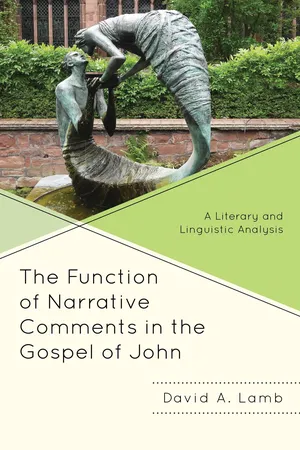
eBook - PDF
The Function of Narrative Comments in the Gospel of John
A Literary and Linguistic Analysis
- 291 pages
- English
- PDF
- Available on iOS & Android
eBook - PDF
The Function of Narrative Comments in the Gospel of John
A Literary and Linguistic Analysis
About this book
Scholars have long noted that comments by the author or editor, often referred to as "narrative asides" or "parentheses," are frequent in the Fourth Gospel. The Function of Narrative Comments in the Gospel of John:A Literary and Linguistic Analysis is a comprehensive guide to this significant feature. In the vein of Gilbert Van Belle's Les Parenthèses dans L'Évangile de Jean (1985), Lamb provides a detailed analysis of the terminology, definition, and categorization of these comments, and interacts extensively with existing scholarship. He looks at the role of the comments in the Gospel's composition, assesses their function using insights from literary theory, dramatic theory, and sociolinguistics, and makes comparisons with OT historical writings, the Synoptic Gospels, and the works of Herodotus and Thucydides. He concludes that the narrative comments are an integral part of the text, which reflect the authority of the author, and that they have significant implications for our exegesis of the Gospel.
Frequently asked questions
Yes, you can cancel anytime from the Subscription tab in your account settings on the Perlego website. Your subscription will stay active until the end of your current billing period. Learn how to cancel your subscription.
At the moment all of our mobile-responsive ePub books are available to download via the app. Most of our PDFs are also available to download and we're working on making the final remaining ones downloadable now. Learn more here.
Perlego offers two plans: Essential and Complete
- Essential is ideal for learners and professionals who enjoy exploring a wide range of subjects. Access the Essential Library with 800,000+ trusted titles and best-sellers across business, personal growth, and the humanities. Includes unlimited reading time and Standard Read Aloud voice.
- Complete: Perfect for advanced learners and researchers needing full, unrestricted access. Unlock 1.4M+ books across hundreds of subjects, including academic and specialized titles. The Complete Plan also includes advanced features like Premium Read Aloud and Research Assistant.
We are an online textbook subscription service, where you can get access to an entire online library for less than the price of a single book per month. With over 1 million books across 1000+ topics, we’ve got you covered! Learn more here.
Look out for the read-aloud symbol on your next book to see if you can listen to it. The read-aloud tool reads text aloud for you, highlighting the text as it is being read. You can pause it, speed it up and slow it down. Learn more here.
Yes! You can use the Perlego app on both iOS or Android devices to read anytime, anywhere — even offline. Perfect for commutes or when you’re on the go.
Please note we cannot support devices running on iOS 13 and Android 7 or earlier. Learn more about using the app.
Please note we cannot support devices running on iOS 13 and Android 7 or earlier. Learn more about using the app.
Yes, you can access The Function of Narrative Comments in the Gospel of John by David A. Lamb in PDF and/or ePUB format, as well as other popular books in Theology & Religion & Historical & Comparative Linguistics. We have over one million books available in our catalogue for you to explore.
Information
Table of contents
- Cover
- Half Title
- Series Page
- Title Page
- Copyright Page
- Contents
- Preface
- Acknowledgments
- List of Abbreviations
- Introduction
- Chapter 1: Survey of Literature
- Chapter 2: Terminology, Definitions, and Categorization
- Chapter 3: An Annotated List of Narrative Comments in the Gospel of John
- Chapter 4: The Process of Composition
- Chapter 5: Whose Comments: The Narrator’s or the Author’s?
- Chapter 6: Towards a Comparative Study
- Conclusions
- Bibliography
- Index of Ancient Sources
- Index of Modern Authors
- About the Author